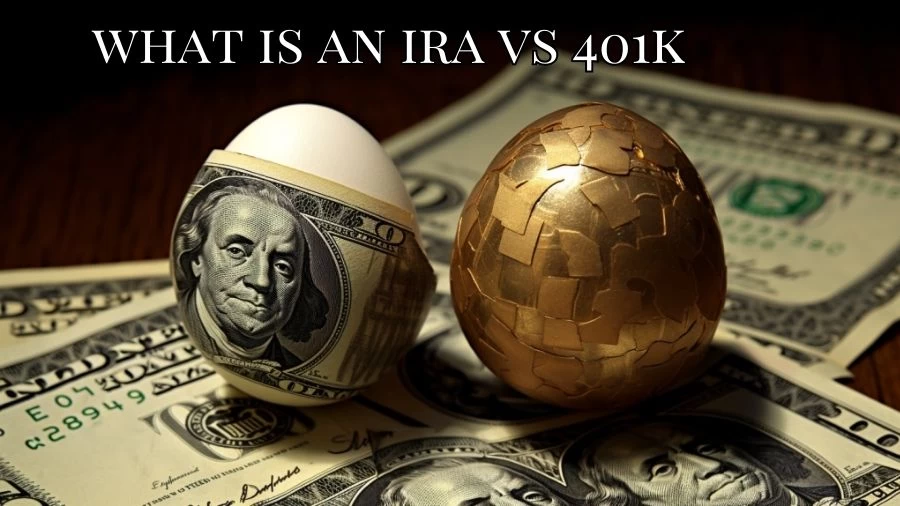
IRA vs 401k, What is the Difference Between IRA and 401k?
IRAs are individually opened diverse investments, $6,500 limit; 401(k)s employer-based, higher contributions, $22,500 limit. Consider matches, investments, taxes for choice.
by Sai V
Published Aug 25, 2023 | Updated Aug 25, 2023 | 📖 10 min read
On This Page
- IRA vs 401k
- Difference Between IRA and 401k
- Benefits of 401k Vs IRA
- Benefits of Roth IRA Vs 401k
- Which Option is More Favorable, Having an IRA or a 401(K)?
- What's the Definition of a 401(K)?
- What Does the Term "Traditional 401(K)" Refer to?
- What Does "Roth 401(K)" Mean?
- What Occurs With Your 401(K) When You Switch Jobs?
- What are the Steps Involved in Withdrawing Money From a 401(K) Plan?
IRA vs 401k
An IRA versus a 401(k) comparison revolves around the primary distinction between these retirement savings options. While 401(k)s are accessible through employers, IRAs are established by individuals through financial institutions such as brokers or banks. IRAs generally offer a more extensive array of investment selections, whereas 401(k)s permit higher yearly contributions.
When deciding between an IRA and a 401(k), it's pivotal to recognize that both, including Roth IRAs, present valuable tax advantages, often allowing individuals to contribute to both types of accounts. In 2023, the contribution ceiling for 401(k)s stands at $22,500 ($30,000 for those aged 50 or above), while IRAs have a limit of $6,500 ($7,500 for those aged 50 and above).
When navigating the IRA versus 401(k) dilemma, a swift approach to determine where to allocate funds initially involves considering factors such as employer matches, investment preferences, contribution limits, tax implications, and account flexibility.
|
Aspect |
IRA |
401(k) |
|
Origin |
Opened individually via broker or bank. |
Offered through employers. |
|
Investment Options |
Offers diverse investment choices. |
Limited investment options set by the employer. |
|
Tax Benefits |
Traditional: Tax-deferred growth. |
Traditional: Pre-tax contributions. |
|
Roth: Tax-free growth and withdrawals. |
Roth: After-tax contributions, tax-free withdrawals. |
|
|
Contribution Limit (2023) |
$6,500 ($7,500 if 50 or older). |
$22,500 ($30,000 if 50 or older). |
|
Employer Match |
Not applicable. |
Often includes matching contributions. |
|
Tax Considerations |
Tax treatment varies based on type. |
Tax treatment varies based on type. |
|
Flexibility |
Offers more investment control. |
Limited to employer's plan options. |
|
Portability |
Can be taken across job changes. |
Tied to the employer, may be transferable. |
Difference Between IRA and 401k
A comparison between a Traditional IRA and a 401(k) revolves around retirement saving methods, where each plan operates under distinct regulations. A 401(k) functions as an employer-sponsored retirement account, while an IRA stands as an individual retirement account. Pertaining to taxes, both options warrant considerations.
At H&R Block, we provide comprehensive tax support, offering various avenues for filing taxes, including in-person and virtual assistance. Our services take into account the intricate tax regulations pertaining to retirement savings, ensuring the preparation of precise tax returns that optimize eligible tax deductions.
|
Aspect |
Traditional IRA |
401(k) |
|
Account Type |
Individual Retirement Account |
Employer Retirement Account |
|
Administration |
Managed individually |
Provided by the employer |
|
Tax Considerations |
Tax-deferred contributions |
Tax-deferred contributions |
|
Contribution Limits |
Generally lower limits |
Generally higher limits |
|
Investment Flexibility |
Broader investment choices |
Limited to employer options |
|
Access to Funds |
Penalty for early withdrawal |
Penalty for early withdrawal |
|
Tax Treatment in Retirement |
Taxed upon withdrawal |
Taxed upon withdrawal |
|
Employer Involvement |
Not linked to employment |
Tied to current employer |
|
Portability |
Easily transferable |
May have restrictions |
Benefits of 401k Vs IRA
|
Benefits |
401(k) Plans |
IRAs |
|
Flexibility |
Convenient due to automatic paycheck deductions |
Offers greater investment choice and variety |
|
Portability |
Offers limited portability when changing jobs |
Provides more control and portability |
|
Employer Match |
Often includes employer match for contributions |
No employer match, but greater investment choice |
|
Contribution Ease |
Automatic deductions from paychecks |
Contributions made on your terms |
|
Investment Options |
Limited options, may include target-date funds |
Wide range of investment options available |
|
Tax Advantages |
Traditional and Roth options available |
Traditional and Roth options with tax benefits |
|
Owner Control |
Employer-sponsored, some control restrictions |
More control and flexibility as the account owner |
Benefits of Roth IRA Vs 401k
|
Benefits |
Roth IRA |
401(k) Plan |
|
Tax Advantage |
Contributions are made with post-tax dollars; growth is tax-free. |
Contributions are pre-tax, reducing current taxable income. |
|
Investment Choices |
Offers a wide range of investment options for portfolio diversity. |
Provides investment choices, usually limited to a selection. |
|
Flexibility |
Independent account not tied to employment status. |
Tied to employment; can be rolled over upon job change. |
|
Required Distributions |
No mandatory withdrawals; allows longer tax-free growth. |
Requires mandatory distributions at a certain age. |
|
Spousal Participation |
Non Working spouses can have a Roth IRA under the working spouse's income. |
No provision for non working spouse's participation. |
|
Contribution Limits |
Lower annual limits compared to 401(k) plans. |
Higher limits, allowing larger contributions. |
|
Employer Matching |
No employer matching since it's an individual account. |
Employer match adds to retirement savings. |
|
Tax Savings |
Provides tax-free growth; withdrawals in retirement are tax-free. |
Offers immediate tax reduction through pre-tax contributions. |
|
Portability |
Can be held independently, unaffected by job changes. |
Portable, can be rolled over into a new employer plan or IRA. |
Which Option is More Favorable, Having an IRA or a 401(K)?
Determining the preferable choice between an IRA and a 401(k) hinges on individual factors such as income, retirement aspirations, and broader financial particulars. For those eligible, 401(k)s generally offer advantages, especially when accompanied by an employer match. On the other hand, IRAs find their strength in being an excellent avenue for individuals without access to employer-sponsored retirement plans.
They also extend to spousal IRAs, allowing working partners to allocate retirement funds on behalf of their non-working counterparts. Moreover, if the aim is to augment retirement savings beyond workplace offerings, an IRA can function as a valuable means to that end.In contemplating the more suitable option between an IRA and a 401(k), the variables at play include personal earnings, retirement ambitions, and holistic financial circumstances.
For individuals able to partake, 401(k)s tend to hold appeal, particularly in cases where there's an accompanying employer contribution. Conversely, IRAs carve a niche by catering well to those lacking access to company-provided retirement schemes.
This scope extends to spousal IRAs, a vehicle enabling employed spouses to allocate retirement funds for their non-working counterparts. Furthermore, should the objective be an increased retirement nest egg that surpasses what one can accrue through employment, an IRA can serve as a constructive avenue for supplementary savings.
What's the Definition of a 401(K)?
What is the meaning of a 401(k) retirement plan? A 401(k) is a savings scheme that offers tax benefits, allowing you to set aside a part of your earnings for your retirement. Upon enrolling in your employer's 401(k) program, you commit to having a percentage of each paycheck automatically placed into your individual 401(k) account. Additionally, your employer might contribute by matching a portion or the entirety of your contributions.
The funds within your 401(k) account can be invested in various choices, usually mutual funds or exchange-traded funds. These investments experience tax-favored growth, safeguarding you from income tax and capital gains tax liabilities. There exist two primary types of 401(k) accounts: the traditional and the Roth.
The distinction lies in the timing of tax payments on your contributions. In a traditional 401(k), your contributions are made using pre-tax income, resulting in taxes being paid upon withdrawal during your retirement. On the other hand, a Roth 401(k) entails contributions from post-tax income, generally allowing for tax-free withdrawals in your retirement years.
What Does the Term "Traditional 401(K)" Refer to?
The concept of a "Traditional 401(k)" pertains to a retirement savings arrangement where contributions are extracted from your earnings prior to the calculation of your taxable income. In essence, this upfront deduction serves to immediately curtail your taxable income, yielding potential immediate tax advantages.
The funds that you contribute are then channeled into investments like mutual funds, fostering their appreciation over time. Subsequently, upon withdrawal of funds from your Traditional 401(k) during your retirement phase, the withdrawn amount becomes subject to regular income tax rates.
What Does "Roth 401(K)" Mean?
A Roth 401(k) is a retirement savings arrangement where you put in money after having paid your income taxes. Unlike a traditional 401(k), there's no immediate tax deduction for your contributions. Nevertheless, similar to a Roth IRA, you won't be taxed on eligible withdrawals, especially those taken after reaching 59 ½ years of age, provided your initial contribution was made at least five years prior.
Opting for a Roth 401(k) could be a smart move if you predict being in a higher tax bracket after you retire compared to your current situation. This is particularly applicable for young professionals who are embarking on their careers with modest earnings and lower tax brackets. If your employer provides both types of 401(k) plans, you can even contribute to both simultaneously.
When making the decision between a traditional and Roth 401(k), or even when thinking about distributing contributions between the two, seeking advice from a tax expert or financial consultant is a prudent step.
What Occurs With Your 401(K) When You Switch Jobs?
Steer Clear of Early Withdrawals: When transitioning jobs, it's advisable to avoid prematurely withdrawing funds from your 401(k) due to potential penalties. If you're below 59½ years of age, withdrawing before this age might incur a 10% early withdrawal penalty, coupled with income tax for traditional 401(k) balances.
Balances Below $1,000: If your 401(k) balance is less than $1,000, the plan administrator could issue a payment to you. This allows a 60-day window for reinvesting the amount into an IRA or your new employer's 401(k) to sidestep additional penalties.
Balances Between $1,000 and $5,000: For balances ranging between $1,000 and $5,000, the administrator can establish an IRA under your name and perform a transfer of the balance into this account.
Option to Leave with Former Employer: Certain 401(k) plans permit you to retain funds within the account even after leaving the company. However, this might result in multiple 401(k) accounts as your career progresses. Some employers might impose a requirement to withdraw or roll over the funds within a specified timeframe.
Transferring to a New Employer's Plan: In certain situations, you could move your former 401(k) balance into your new employer's plan, although not all plans facilitate this transfer. It's essential to inquire with your new employer and adhere to the correct procedure for executing the transfer.
Rolling Over to an IRA: Another alternative is to transfer the 401(k) balance into an Individual Retirement Account (IRA). To avoid penalties, ensure a trustee-to-trustee transfer is conducted. Conventional 401(k) funds should find a place in a traditional IRA, while Roth funds should be allocated to a Roth IRA.
Utilizing IRA Custodians: Numerous IRA custodians allow you to establish a dedicated rollover IRA account. This approach alleviates concerns regarding contribution limits and taxation matters.
What are the Steps Involved in Withdrawing Money From a 401(K) Plan?
401(k) Purpose and Overview:
- A 401(k) plan is designed to serve as a source of income during retirement.
Age Limit for Penalty-Free Withdrawals:
- You cannot make penalty-free withdrawals from a 401(k) until you reach the age of 59 ½.
Early Withdrawal Tax Penalty:
- If you withdraw funds before the age of 59 ½, a tax penalty of 10% is imposed on the withdrawn amount.
- Additionally, a mandatory 20% income tax withholding is applied for traditional 401(k) withdrawals made before the eligible age.
Exceptions to Penalty:
- There are certain exceptions to the early withdrawal penalty, although these exceptions are not detailed here.
Age-Eligible Withdrawals:
- Upon reaching the age of 59 ½, you have the option to start making withdrawals from your 401(k) account without incurring the early withdrawal penalty.
Required Minimum Distributions (RMDs):
- By the time you reach age 72, you are required to initiate withdrawals from your 401(k) account.
- These mandatory withdrawals are referred to as Required Minimum Distributions (RMDs).
IRA vs 401k - FAQs
1. What is the main difference between an IRA and a 401(k)?
IRA is individually established, while 401(k) is employer-sponsored.
2. What are the contribution limits for IRAs and 401(k)s in 2023?
IRAs have a limit of $6,500 ($7,500 if 50+), 401(k)s allow up to $22,500 ($30,000 if 50+).
3. What's the key advantage of a Roth IRA over a traditional 401(k)?
Roth IRA offers tax-free growth and withdrawals, while traditional 401(k) withdrawals are taxed.
4. Can you have both an IRA and a 401(k) simultaneously?
Yes, you can contribute to both IRA and 401(k) accounts.
5. What happens to your 401(k) when you change jobs?
You can leave it, transfer to a new employer's plan, roll over to an IRA, or withdraw (subject to penalties).




